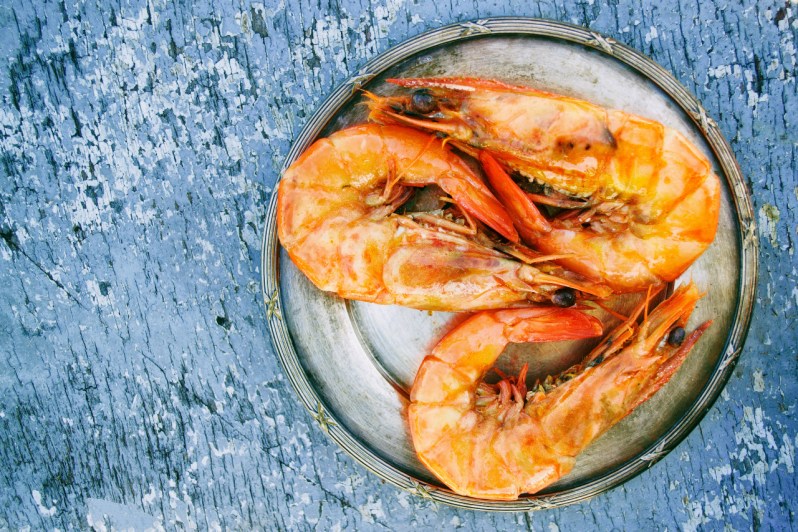
Packed with flavor, grilled shrimp is great as an appetizer or entre. However, grilling shrimp can also be challenging because there’s an endless variety of delicious spices and ingredients to choose from.
Here to help is Chef David Guas, the 2019 Wild American Shrimp Chef of the Year. A New Orleans-born TV personality and chef, Chef Guas appeared on “The Today Show,” “The Talk,” “Chopped,” “Chopped Junior,” and is the host and co-judge of Travel Channel’s summer competition series, “American Grilled.” Chef Guas has also garnered national praise in publications like Food and Wine, Southern Living, Garden & Gun, Saveur, and Bon Appétit for showcasing the soul of the South at Bayou Bakery.
Grilled Head-On New Orleans-Style BBQ Shrimp
(By Chef David Guas of Bayou Bakery Coffee Bar & Eatery in Arlington, Virginia)

This shrimp recipe is from Chef Guas’s cookbook Grill Nation: 200 Surefire Recipes, Tips, and Techniques to Grill like a Pro.
Ingredients:
- 6 (12-inch) wooden skewers
- 2 lb. unpeeled, raw, Wild American Shrimp
- ¼ cup olive oil
- 10 tbsp, butter
- 1 tsp, whole black peppercorns
- 2 bay leaves
- 3 tbsp, minced garlic cloves
- 2 tbsp, chopped fresh rosemary
- ½ cup Worcestershire sauce
- ½ tsp, freshly ground black pepper
- 1 French bread baguette, sliced
- 4 tbsp, extra virgin olive oil
- Table salt
Method:
- Soak skewers in warm water 20 to 30 minutes. This step will help the wooden skewers from burning.
- Peel shrimp, keeping heads on. Reserve the shells.
- Heat 2 tbsp olive oil and 2 tbsp butter in a pan over medium-high heat. Add shells, peppercorns, and bay leaves. Cook 3 minutes or until shells change color.
- Add 2 cups water, increase heat, and simmer 10 to 12 minutes. Remove from heat and pour through a fine wire-mesh strainer into a bowl. Discard solids and reserve stock.
- Light charcoal grill or preheat gas grill to 350-400 degrees (medium-high).
- Thread shrimp on skewers.
- Heat remaining 2 tbsp olive oil in pan over medium-high heat 1 minute. Add garlic and cook 1 minute. Reduce heat to medium. Add rosemary and cook 2 minutes.
- Add Worcestershire sauce, pepper and 1 cup reserved shrimp stock. Increase heat and simmer until reduced by half.
- Brush some of sauce over shrimp, reserving remaining sauce.
- Place skewers on cooking grate; grill 2 minutes on each side.
- Slice bread and brush with extra virgin olive oil. Season with salt. Grill until toasted.
- Reheat remaining sauce over medium-high heat; whisk in remaining 8 tbsp butter, 2 tbsp at a time.
- Place 1 skewer of shrimp on each serving plate, top with sauce, and serve with bread.
Selecting and Cleaning Shrimp
For Chef Guas, selecting the best shrimp is all about your senses. “Always trust your nose and your touch,” says Chef Guas. “If the shrimp are a bit slimy or they smell like they have been sitting out of refrigeration for a bit (even though they may be displayed on ice) then do not buy them.” For head-on shrimp, Chef Guas pays special attention if the heads are separated — this can often be a sign that the shrimp isn’t fresh. However, shell-on shrimp does have its benefits — the shells can be used for stock and sauces.
To defrost frozen shrimp, Chef Guas’ advice is to place the frozen shrimp in a container and refrigerate overnight. Generally, 5 lbs of shrimp will take a day and a half to defrost fully. If in a hurry, Chef Guas likes to place his shrimp in a metal or plastic container in an empty sink and run cold water directly over the top until the shrimp has broken free from the ice.
Although most local seafood markets or grocery stores will have cleaned and deveined shrimp, these will often be more expensive. Also, certain varieties of shrimp are sometimes only sold with the shell-on. To clean your own shrimp, Chef Guas advocates using a very sharp knife for this process. Run the knife along the back, cutting into the shell — about ¼ deep into the meat of the shrimp. Next, take your knife and cut about ¾ down the entire back of the shrimp. Finally, to peel the shell off, pinch the tail and gently pull the shell from its attached tail. There will also be a black vein running down the back of each shrimp after its been cut. To remove, rinse under cold water.
Seasoning and Grilling

Shrimp marinates quickly as it doesn’t take a lot seasoning to penetrate the meat. Marinades work best on peeled shrimp as the ingredients will not be obstructed by the shell. Any variety of spices, aromatics or herbs are great, ranging from spicy peppers to citrus.
Shrimp also cooks quickly. Depending on the size and the heat source, shrimp takes 3-4 minutes to cook thoroughly. On the grill, shrimp should only be cooked on direct heat for about 2 minutes on each side. The color will change as it reaches doneness, changing to orange once they’re cooked.
Related Guides
Sustainability
Finally, a word about sustainability. While there’ area lot of different shrimp species available in the marketplace, many of them are not sustainable. American shrimp consumption has increased dramatically in recent years — 49 percent of American families purchased shrimp in 2018, a record high according to Seafood News.

Generally, farmed shrimp from places like Vietnam or the Gulf of Mexico are not sustainable. Not all farmed shrimp are bad — some varieties of giant tiger prawns are raised in environmentally friendly ponds. In most cases, though, wild caught shrimp are a better choice, although this largely depends on the fishing method and species. For instance, the common shrimp or brown tiger prawns caught with non-invasive fishing methods are great options. For the best information on sustainability, visit Monterey Bay Aquarium Seafood Watch for a comprehensive list.



